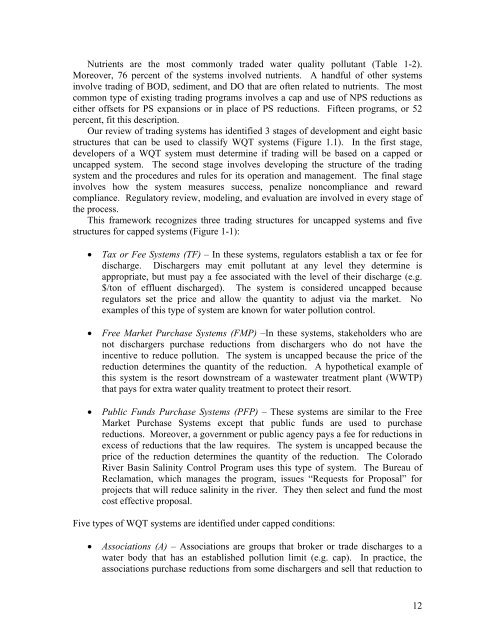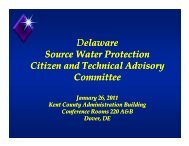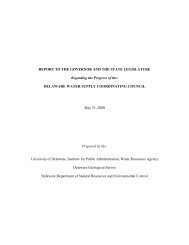Water Quality Trading in the Lower Delaware River Basin: A ...
Water Quality Trading in the Lower Delaware River Basin: A ...
Water Quality Trading in the Lower Delaware River Basin: A ...
You also want an ePaper? Increase the reach of your titles
YUMPU automatically turns print PDFs into web optimized ePapers that Google loves.
Nutrients are <strong>the</strong> most commonly traded water quality pollutant (Table 1-2).<br />
Moreover, 76 percent of <strong>the</strong> systems <strong>in</strong>volved nutrients. A handful of o<strong>the</strong>r systems<br />
<strong>in</strong>volve trad<strong>in</strong>g of BOD, sediment, and DO that are often related to nutrients. The most<br />
common type of exist<strong>in</strong>g trad<strong>in</strong>g programs <strong>in</strong>volves a cap and use of NPS reductions as<br />
ei<strong>the</strong>r offsets for PS expansions or <strong>in</strong> place of PS reductions. Fifteen programs, or 52<br />
percent, fit this description.<br />
Our review of trad<strong>in</strong>g systems has identified 3 stages of development and eight basic<br />
structures that can be used to classify WQT systems (Figure 1.1). In <strong>the</strong> first stage,<br />
developers of a WQT system must determ<strong>in</strong>e if trad<strong>in</strong>g will be based on a capped or<br />
uncapped system. The second stage <strong>in</strong>volves develop<strong>in</strong>g <strong>the</strong> structure of <strong>the</strong> trad<strong>in</strong>g<br />
system and <strong>the</strong> procedures and rules for its operation and management. The f<strong>in</strong>al stage<br />
<strong>in</strong>volves how <strong>the</strong> system measures success, penalize noncompliance and reward<br />
compliance. Regulatory review, model<strong>in</strong>g, and evaluation are <strong>in</strong>volved <strong>in</strong> every stage of<br />
<strong>the</strong> process.<br />
This framework recognizes three trad<strong>in</strong>g structures for uncapped systems and five<br />
structures for capped systems (Figure 1-1):<br />
• Tax or Fee Systems (TF) – In <strong>the</strong>se systems, regulators establish a tax or fee for<br />
discharge. Dischargers may emit pollutant at any level <strong>the</strong>y determ<strong>in</strong>e is<br />
appropriate, but must pay a fee associated with <strong>the</strong> level of <strong>the</strong>ir discharge (e.g.<br />
$/ton of effluent discharged). The system is considered uncapped because<br />
regulators set <strong>the</strong> price and allow <strong>the</strong> quantity to adjust via <strong>the</strong> market. No<br />
examples of this type of system are known for water pollution control.<br />
• Free Market Purchase Systems (FMP) –In <strong>the</strong>se systems, stakeholders who are<br />
not dischargers purchase reductions from dischargers who do not have <strong>the</strong><br />
<strong>in</strong>centive to reduce pollution. The system is uncapped because <strong>the</strong> price of <strong>the</strong><br />
reduction determ<strong>in</strong>es <strong>the</strong> quantity of <strong>the</strong> reduction. A hypo<strong>the</strong>tical example of<br />
this system is <strong>the</strong> resort downstream of a wastewater treatment plant (WWTP)<br />
that pays for extra water quality treatment to protect <strong>the</strong>ir resort.<br />
• Public Funds Purchase Systems (PFP) – These systems are similar to <strong>the</strong> Free<br />
Market Purchase Systems except that public funds are used to purchase<br />
reductions. Moreover, a government or public agency pays a fee for reductions <strong>in</strong><br />
excess of reductions that <strong>the</strong> law requires. The system is uncapped because <strong>the</strong><br />
price of <strong>the</strong> reduction determ<strong>in</strong>es <strong>the</strong> quantity of <strong>the</strong> reduction. The Colorado<br />
<strong>River</strong> Bas<strong>in</strong> Sal<strong>in</strong>ity Control Program uses this type of system. The Bureau of<br />
Reclamation, which manages <strong>the</strong> program, issues “Requests for Proposal” for<br />
projects that will reduce sal<strong>in</strong>ity <strong>in</strong> <strong>the</strong> river. They <strong>the</strong>n select and fund <strong>the</strong> most<br />
cost effective proposal.<br />
Five types of WQT systems are identified under capped conditions:<br />
• Associations (A) – Associations are groups that broker or trade discharges to a<br />
water body that has an established pollution limit (e.g. cap). In practice, <strong>the</strong><br />
associations purchase reductions from some dischargers and sell that reduction to<br />
12




